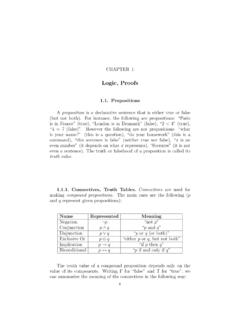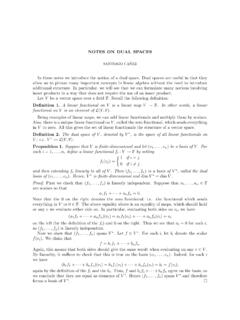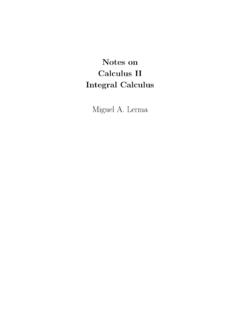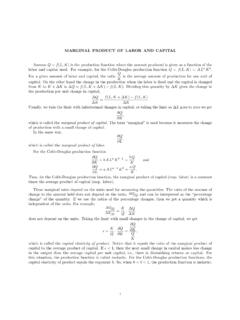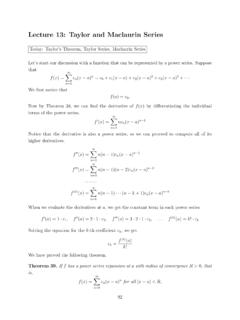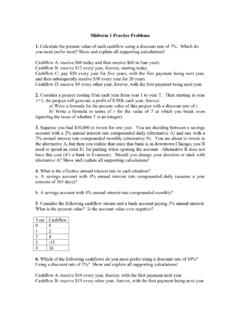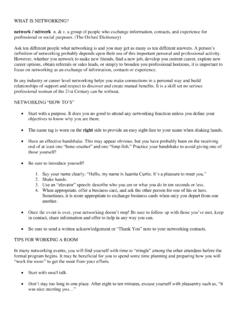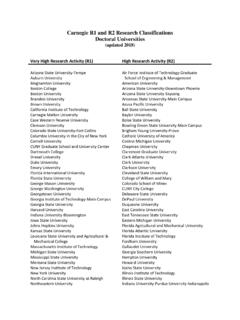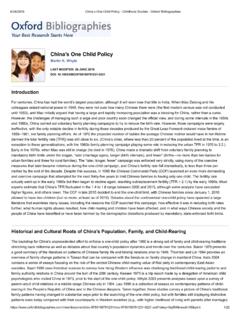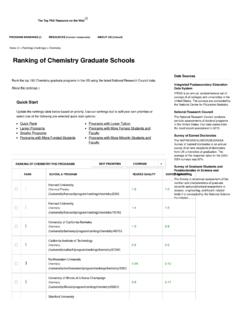Transcription of RING THEORY 1. Ring Theory - Northwestern University
1 CHAPTER IVRING THEORY1. ring TheoryAringis a setAwith two binary operations satisfying the rules given below. Usually one binary operationis denoted + and called addition, and the other is denoted by juxtaposition and is called multiplication. The rules required of these operations are:1)Ais an abelian group under the operation + (identity denoted 0 and inverse ofxdenoted x);2)Ais a monoid under the operation of multiplication ( , multiplication is associative and there is atwo-sided identity usually denoted 1);3) the distributive laws(x+y)z=xy+xzx(y+z)=xy+xzhold for allx,y, one does not require that a ring have a multiplicative identity. The word ring may also beused for a system satisfying just conditions (1) and (3) ( , where the associative law for multiplicationmay fail and for which there is no multiplicative identity.
2 Lie rings are examples of non-associative ringswithout identities. Almost all interesting associative rings do have 1 = 0, then the ring consists of one element 0; otherwise 16= 0. In many theorems, it is necessary tospecify that rings under consideration are not trivial, that 16= 0, but often that hypothesis will not bestated the multiplicative operation is commutative, we call the ring Algebraisthe study of commutative rings and related structures. It is closely related to algebraic number THEORY andalgebraic a ring , an elementx2 Ais called aunitif it has a two-sided inversey, 1. Clearlythe inverse of a unit is also a unit, and it is not hard to see that the product of two units is a unit.
3 Thus, thesetU(A) of all units inAis a group under multiplication. (U(A) is also commonly denotedA .) If everynonzero element ofAis a unit, thenAis called adivision ring (also a skew field.) A commutative divisionring is called a :1)Zis a commutative (Z)=f1, ) The groupZ/nZbecomes a commutative ring where multiplication is multiplication (Z/nZ)consists of all cosetsi+nZwhereiis relatively prime ) LetFbe a field, ,F=RorC. LetMn(F)denotethesetofnbynmatrices with entries inF. Add matrices by adding corresponding entries. Multiply matrices by the usual rule for matrixmultiplication. The result is a non-commutative (Mn(F)) =Gl(n, F) = the group of ) LetMbe any abelian group, and let End(M) denote the set of endomorphisms ofMinto , g2 End(M), define addition by (f+g)(m)=f(m)+g(m), and define multiplication ascomposition of functions.
4 (Note: IfMwere not abelian we could still define composition because thecomposition of two endomorphisms is an endomorphism. However, it would not necessarily be truethat the sum of two endomorphisms would be an endomorphism. Check this for yourself.)Typeset byAMS-TEX3132IV. ring THEORYIfAis a ring , a subsetBofAis called asubringif it is a subgroup under addition, closed undermultiplication, and contains the identity. (IfAorBdoes not have an identity, the third requirement wouldbe dropped.)Examples:1)Zdoes not have any proper ) The set of all diagonal matrices is a subring ofMn(F).3) The set of allnbynmatrices which are zero in the last row and the last column is closed underaddition and multiplication, and in fact it is a ring in its own right (isomorphic toMn 1(F).
5 However, it is not a subring since its identity does not agree with the identity of the overringMn(F).A functionf:A!BwhereAandBare rings is called a homomorphism of rings if it is a homomorphismof additive groups, it preserves products:f(xy)=f(x)f(y) for allx, y2A, and finally it preserves theidentity:f(1) = : The canonical epimorphismZ!Z/nZis a ring homomorphism. However, the inclusion ofMn 1(F)inMn(F) as suggested in example 3) above is not a ring subsetais called aleft idealofAif it is an additive subgroup and in additionax2awhenevera2 Aandx2a. If we require instead thatxa2a,thenais called arightideal. Finally,ais called atwo-sidedideal if it is both a left ideal and a right ideal.
6 Of course, for a commutative ring all these notions are :1) It is easy to see that any additive subgroupnZis an ideal ) LetA=Mn(F). LetLjbe the set ofnbynmatrices which are zero except possibly in thejthcolumn. It is not hard to see thatLjis a left ideal inA. Can you give an example of a right ideal?There are no two-sided ideals inA. (See the Exercises.)The following notation is useful. Letaandbbe subsets ofA, at least one of which is an additive subgroupofA. Letabdenote the set of all sums of elements of the formabwitha2aandb2b. It is not hard tosee thatabis an additive subgroup ofA. (Clearly, it is closed under addition. Can you see why it is closedunder taking negatives additive inverses?
7 Using this notation, an additive subgroupaofAis a leftideal if and only ifAa a left ideal ofA, and ifa=Ax1+Ax2+ +Axwe say thatais generated byx1,..,xn. (Note that all the notation used above has been defined already, atleast if we use the shorthandAx=Afxg.) Ifa=Axis generated by a single element, we call it aprincipalleft ideal. Similar concepts apply to right ideals. In a commutative ring , of course, we need not distinguishso we just use the terms principal ideal. A ring is called aprincipal ideal ringif it is a commutative ring and every ideal is principal. The principalideal ring which should come immediately to mind isZ. (We saw in an exercise that every subgroup ofZis of the formnZfor some non-negative integern, so the same is true for every ideal.)
8 In fact, forZ,everyadditive subgroup is an ideal.)We can repeat much of the THEORY of groups, subgroups, and normal subgroups in the context of rings,subrings, and (two-sided) :A!Bbe a homomorphism of rings. It is easy to see that the image of the homomorphism isa subring ofB. Letbbe an ideal inB(left, right, or two-sided). Thenf 1(b)=fa2 Ajf(a)2bgis anideal inA(respectively left, right, or two-sided.) For, it is certainly a subgroup, anda2A, x2f 1(b))f(ax)=f(a)f(x)2bsoax2f 1(b). In particular,f0gis a two-sided ideal inBso Kerf=f 1(0) is atwo-sided ideal a ring and letabe an ideal (always two-sided if not further specified.) Sinceais a subgroupofAas abelian group, we may construct the factor groupA/a.
9 As usual, it consists of all co-setsx+ a ring as follows. First note that forx,y2A,thecosetxy+adepends only on the cosets ofxandy. For,x x0moda,y y0moda)x x0andy ,xy x0y0=xy x0y+x0y x0y0=(x x0)y+x0(y y0)2asinceais a two-sided ideal. Hencexy x0y0modaas claimed. It follows that we can define a binary operation onA/aby setting(x+a)(y+a)=xy+ MAXIMAL IDEALS33We leave it to the student to show thatA/abecomes a ring with respect to the operations of addition andmultiplication inherited fromA. (You need to show that the associative law for multiplication holds, 1 +ais a two-sided identity, and the two distributive laws hold. These follow easily from the corresponding factsinA.
10 A/ais called thefactorring ofAmoduloa. Note that the canonical group epimorphismA!A/aisa ring homomorphism in essence because the product on the right is defined to make it may now restate the basic isomorphism theorems for groups. To prove them, one need only checkthat the basic isomorphisms preserve products as well as sums. (That they preserve sums follows becausethe group theoretic theorems apply already to the additive groups.)Theorem.(First Isomorphism Theorem). Letf:A!Bbe a homomorphism of groups. Definef:A/Kerf!Imfbyf(a+Kerf)=f(a). Thenfis a ring (Second Isomorphism Theorem). LetA0be a subring ofA, and letabe an ideal +ais a subring ofAandx+A\a x+adefines a ring isomorphismA0/A0\a =(A0+a) (Third Isomorphism Theorem).
